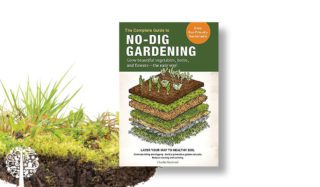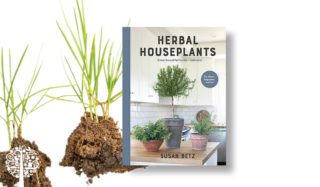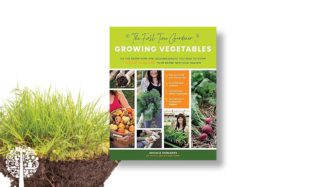You’ve worked hard in the garden this season, nurturing your plant babies from seed to harvest! But before heading out to gather your crops, here are a few words of advice in our list of 5 Cool Ways Gardening Experts Harvest Their Plants. Happy Harvesting!

Harvest Tips
The Right Tools
Harvesting plants doesn’t have to be complicated; carefully using your hands is all it takes to get the job done. But a few tools on the market can make foraging more efficient and fun! Abby Artemisia – botanist, herbalist, and professional forager – knows a thing or two about harvesting plants! In her book, The Herbal Handbook for Homesteaders: Farmed and Foraged Herbal Remedies and Recipes, she recommends a fixed blade knife or pocketknife that can be safely stowed in a sheath on your belt. Her favourite tool is a Japanese digging knife (also known as a Hori Hori) because it’s like a trowel and knife in one and makes many garden tasks much easier. A good set of pruners are another go-to, and she suggests trying a few different pairs until you find some that fit well and feel comfortable in your hand. Of course, no serious gardener should go without gloves, and for those days where you might be harvesting out in the hot sun for a couple of hours, a cooler and some ice packs are ideal.

Herbal Handbook
No Diggity
If you’re a fan of no-dig gardening methods, you know that keeping precious soil life intact is essential through all stages of growth, including harvest! Charlie Nardozzi, gardening expert and the author of The Complete Guide to No-Dig Gardening: Grow beautiful vegetables, herbs, and flowers – the easy way! recommends that gardeners adjust their technique when it comes to harvesting certain crops. For example, when it’s time to pick greens such as spinach, lettuce, and bok choi, cutting the plants at the soil line leaves the earth undisturbed. The same rule applies to cauliflower and cabbage. This way, the root system stays in the ground and feeds the soil as it decomposes. With root crops, things get a little trickier, but Nardozzi says a healthy garden bed with plenty of compost allows for easier pulling. He recommends gently tugging on carrots, beets, and parsnips by hand to remove them from the ground; after harvest, cover the bed with mulch to keep weeds from germinating.

No-Dig Gardening
Sage Advice
Harvesting fresh herbs throughout the summer for your meals is lovely, but when the first frost looms, you hate to see your basil, rosemary, and chives go to waste. Luckily, there are many ways you can pick and preserve your herbs so you can enjoy them throughout the colder months! Master Gardener, Susan Betz, recommends snipping bunches of herbs at the soil line and air-drying them. After harvest, tie the base of the herbs together with a rubber band to make bunches, then hang them in an area of your home with good cross ventilation. Drying time should take anywhere from two days to a few weeks; you’ll know they’re ready when they’re crispy to the touch. Store the dried herbs in clean glass jars for the best flavour and fragrance. Another way to preserve your herbal harvest is to freeze the plants while they’re fresh. Betz suggests chopping the herbs first; they store well in containers in the freezer for up to eight months. You can also turn your harvest into pestos, butter, and herbal vinegar. For more herb garden tips, check out Betz’s book, Herbal Houseplants: Grow beautiful herbs – indoors!

Herbal Houseplants
Bugs Happen
There’s nothing better than knowing how your food was grown and where it comes from, but that doesn’t mean your harvest won’t be dirty and come with a bug or two. Sometimes, a quick rinse doesn’t do the trick, especially with food with crevices or hiding spots. So what’s a home gardener to do? Don’t freak out, says Jessica Sowards of Roots and Refuge Farm. Although an excellent source of protein, perhaps you’re just not ready for caterpillars on your dinner plate. Sowards suggests dissolving 3 tablespoons of table salt in a large bowl of cool water. Soak veggies like cauliflower, broccoli, and leafy greens for about 20 minutes. After the salt water bath, all of the insects should be gone. Rinse the plants and enjoy them, bug-free, for dinner. For more fantastic gardening tips from Sowards, check out her book, The First-Time Gardener: Growing Vegetables – All The Know-How And Encouragement You Need To Grow And Fall In Love With Your Brand New Food Garden.

The First Time Gardner
Seed Saving
Last but certainly not least, let’s talk about seed saving, which we can all do to save money in the garden. But harvesting seeds is an art. Julie Thompson-Adolf, writer and blogger of Garden Delights, says it’s essential to consider your plants when harvesting seeds. Are they super productive or riddled with pests and disease? Are they quick to produce fruit, or has your hair gone grey waiting for harvest? The only way to select desirable plants is to observe them throughout the growing season and take notes on how they perform. For best results in the garden, save seeds from mature plants that are healthy, productive, drought-tolerant, and disease-resistant. Another tip? In Starting & Saving Seeds: Grow The Perfect Vegetables, Fruits, Herbs, And Flowers For Your Garden, Thompson-Adolf says bigger is better. She says the largest seeds from your harvest will generally produce the most vigorous plants. Don’t forget to properly process and label the seeds in a packet, storing them in a cool, dry place until you’re ready to use them.

Starting And Saving Seeds